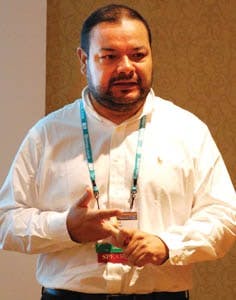Occidental Overcomes Rough Terrain by Automating 200 Wells with Wireless
Check Out Montague's Google+ profile.
Between its wildly unpredictable weather, limited and costly labor force, and rugged terrain, North Dakota can be a rough neighborhood for process applications. These were a few of the reasons why Occidental Petroleum Corp.'s engineers, technicians and operators were so happy to automate more than 200 wells, tanks and other equipment near Dickinson with wireless transmitters and other components from Emerson Process Management.Located in the harsh and often unforgiving terrain of the geological Bakken region, the company's 200 well pads and their oil and water tanks are widely dispersed, subjected to snow, ice and ambient temperatures that can shift by 80 °F in a day, and typically require large amounts of hardware and costly labor to install and maintain. Each well has six 400-barrel tanks, including four for storing oil and two for storing water. The wells produce light crude oil and slightly salty water.
"We needed to automate our existing and new oil production facilities located near Dickinson for both monitoring and control, so these facilities could be operated remotely from a centralized control room," said Jose Ludena, Occidental's senior facilities engineering advisor. "This project began in 2012 and included the wells, oil and water tanks, heater-treater and well-monitoring systems, and a central tank battery with five 10,000-bbl, fixed-roof tanks, two LACT [leased automatic custody transfer] units, two produced water injection pumps, three crude oil shipping/sales pumps, three flares, a vapor recovery unit (VRU), and all associated electrical infrastructure."
"Wireless eliminated more than 96% of call-outs due to communication or equipment failure issues." Occidental Petroleum's Jose Ludena on the performance of its Emerson Smart Wireless instrument network in a remote North Dakota oil field.
Ludena and James Haw, IT manager for Occidental, presented "Implementing Effective Process Control in a Harsh and Unforgiving Terrain" this week at the Emerson Global Users Exchange in Orlando, Florida.Because of its aggressive project schedule, the bulk of Occidental's well infrastructure, wireless upgrades and other construction had to be executed during the winter. "Heavy snow and/or rain at any time during the year in North Dakota results in very muddy and hazardous driving conditions, making it very difficult to reach facilities, and the state's department of transportation frequently closes roads during inclement weather," said Ludena. "We also had an aggressive central tank battery schedule, and our rapid deployment of wells and infrastructure also required us to build more than 120 of the well pads in less than 18 months. Unfortunately, because there's s much oil and gas-related development in this area, limited resources are locally available, especially skilled labor, and so resources are either brought in from out of state or hired from the existing pool at a premium."
To meet these challenges, Ludena, Haw and their colleagues at Occidental needed a wireless system that could be run reliably in sub-zero and icy conditions. "We installed our wireless components by May 2012; installation was less and required fewer commissioning resources," said Ludena. "We eliminated the bulk of the traditional loop infrastructure, such as conduit, cable, terminal blocks, fuses, etc., and greatly reduced the amount of necessary construction resources. We eliminated point-to-point checkout associated with traditional wired instrument loops. Our mesh network is reliable, self-healing, and it's also easy to expand and add devices to the network."
Ludena added that Occidental's new wireless network on its wells in North Dakota has greatly improved overall reliability. "Implementing wireless eliminated more than 96% of call-outs due to communication or equipment failure issues," reported Ludena. "It also eliminated electrostatic discharge issues while unloading vessels and inherently improved reliability by eliminating problems such as loose connections, cracked insulation, broken wiring and crushed conduit."
Ludena added that cost benefits of Occidental's wireless network include a 35% reduction in overall deployment labor costs and a 15% reduction in overall material costs. "Our original estimate for automating a well pad with a traditional wired solution was seven days, but actual deployment time with wireless is now two days, and it can be even faster for multiple wells located at the same site."
About the Author

Leaders relevant to this article:




